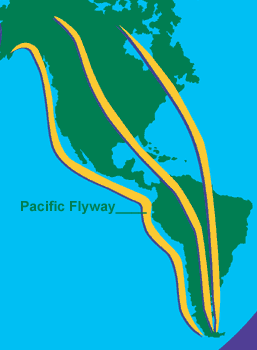American Pacific Flyway

From U.S. Fish and Wildlife Services' Shorebirds Sister Schools Program
http://66.241.214.202/Reference_Desk/Flyways/flyways.cfm
Route Description
The American Pacific Flyway generally follows the eastern Pacific coastline from the western Arctic, including Alaska and the Aleutian Islands, down the Rocky Mountain and Pacific coastal regions of Canada, the United
States, and Mexico, to where it blends with other flyways in Central and South America. This extensive flyway system is separated into four geographic areas: Alaska, the Northern Pacific, the Intermountain West, and the
Southern Pacific Region.
Facts About the Flyway
Alaskan Region
- Alaska’s size and northerly position provide breeding habitat for more types of shorebirds than anywhere else in the United States.
- Of the 71 species which have occurred in this region, 37 breed here.
- Most Alaskan shorebirds migrate to southern areas of the United States and Mexico. About one third head to South America or Oceania (Australia and New Zealand).
- More than one million birds congregate at Alaskan staging sites. In the spring, as many as five to eight million shorebirds use the food resources of the famous Copper River Delta.
Northern Pacific Region
- Estuaries like Gray’s Harbor, Willapa Bay, and Bandon Marsh support over 100,000 shorebirds during peak migration.
- Other important shorebird habitats, such as the Willamette Valley are a mix of wetlands and agriculture and are used extensively in winter by Dunlin and Wilson’s Snipe.
- Of the 50 shorebird species that breed in the United States, 40 are found regularly in this region.
- Important habitats include coastal estuaries, sandy beaches, rocky shorelines, freshwater marshes, pastures, and agricultural lands.
Intermountain West Region (IMW)
- Eleven species of shorebirds breed and another 23 migrate regularly through this huge region that includes a variety of wetlands, from saline sinks to alpine streams.
- Up to 90 percent of the world’s adult Wilson’s Phalaropes molt and stage in the IMW hypersaline lakes prior to their trip to South America.
- Important habitats include large saline lakes, marshes, upland, agricultural fields, ephemeral wetlands, man-made impoundments, and riparian areas.
Southern Pacific Region
- Internationally and nationally significant numbers of Western Sandpipers, Snowy Plovers and Mountain Plovers are found here.
- Important habitats include tidal wetlands and marshes, salt ponds, seasonal wetlands, flooded agricultural lands, managed wetlands, and range and agricultural land.
- Twenty eight species of shorebirds spend the nonbreeding season here.
 Join In
Join In Archives
Archives